Young Nemtsov: “I Can Walk on a Rope Over an Abyss”
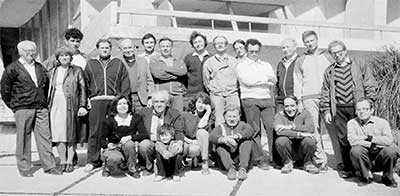
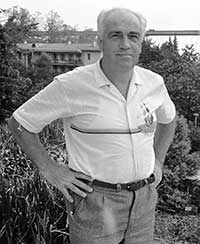
Left: Some participants of Sochi-3 in Malyj Akhun (1986) — first Sochi conference of Nemtsov, standing third from left. Tsytovich is holding Vladimir Zakharov’s child; sitting third from right is Zakharov; sitting first from left is the author. Right: Vadim Tsytovich in Sochi.

Sochi-2 (1985). The slogan on the Sputnik’s main building reads: “WE ARE FOR ANTIIMPERIALISTIC SOLIDARITY!” Sitting second from right is Vadim Tsytovich, standing fourth from right is the author.

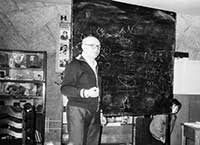
Left: Sochi-4, 1987. Vitaly Ginzburg in the Library of Malyj Akhun. Right: Nezlin describes his brilliant miniature experiment. Nobody was ever able to ruffle the feathers of the ever polite and benevolent uncle Misha.
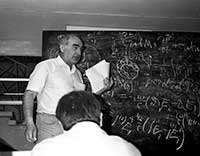

Sochi-3, 1986. Utility room in Malyj Akhun (two days apart). Left: Vitaly Ginzburg on trial. Right: Nemtsov at blackboard. Calm and cocky.
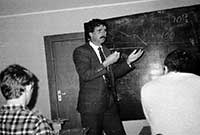
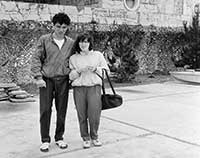
Left: Volodya Dogiel against audience. Right: Raya meets gloomy Nemtsov, determined to fight as long as it takes.
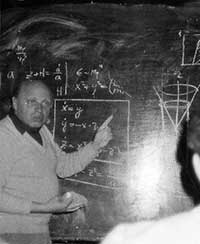

Left: Khalatnikov patiently answers the question. Right: Nearly loosing his temper.

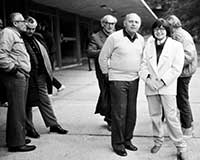
Left: Khalatnikov looks like he’s giving advice to a child, something like, “You don’t want to be like that boy behind you, do you?” Talking to Khalatnikov, first from left, is Misha Rabinovich. Nemtsov’s face clearly shows that he is still ready for confrontation. Right: Still in a good mood. From left to right: Vitalyi Goldanskii, Oleg Belotserkovsky, Vitaly Ginzburg, Isaak Khalatnikov and Margarita Ryutova
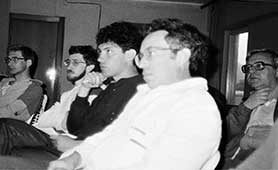
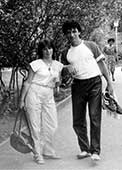
Left: At session. Right: Raya and Borya. Looks like Raya won the game.
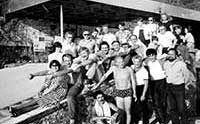

Left: Day break: most of us are still dressed comme il faut for session, some (in fact only Volodya Dogiel and Lev Dorman) are totally ready for the beach. Standing behind me is Raya Nemtova. Borya is second from right, front row. Right: Getting bruises: first attempts.

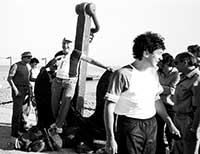
Left: Unhappy trainee and the coach. Right: He did it! Dolphins? Who cares.
By Margarita Ryutova
Editor’s note: Boris Yefimovich Nemtsov (1959–2015), a Russian physicist and politician, was assassinated on February 27 in Moscow. Margarita Ryutova is a physicist and historian at Lawrence Livermore National Laboratory.
I never met Nemtsov the politician. I only knew Nemtsov the physicist, an outspoken, fiery, impulsive young man who had been freshly awarded his degree in physics. I never spoke with him after 1989, the year when he left physics and ran for the Supreme Soviet as a representative of Nizhny Novgorod. He lost. But the failure spurred him, and he was elected the following year. In 1991 Boris Yeltsin appointed him governor of Nizhny Novgorod Oblast, making him youngest ever governor of a region whose population was over 3 million and which had more than 600 industrial establishments including the country’s chief center for nuclear research, Arzamas-16.
Nemtsov in his book, Confessions of a Rebel, recalled [1], “Yeltsin fired everyone who had supported the coup leaders [i.e., of the 1991 August putsch], including all of the leaders of Nizhny Novgorod. Since he knew no one in Nizhny except me, he decided to appoint me ... My first deputy was the experienced Soviet leader Ivan Sklyarov. It was he who decided to teach me the needed smarts.
“‘You know, old man,’ Ivan said, ‘you are young and no one will accept you as governor. You must understand that those are serious people. Far reaching enough to be factory directors, heads of collective farms and research institutions. You need to meet with them and make friends ...’
“'And how should I do this?’
“'Just drink vodka with each of them.’
“'And how many plants do we have?’
“'About five hundred plants, and 750 collective farms...’”
He added, “I came to the government young, inexperienced and naive... I went through a ruthless trashing machine and have not broken. Thank you destiny.”
Such was the beginning of Nemtsov’s breathtaking political career, full of sharp ups and downs until his gruesome death. I will limit this story, though, to Nemtsov’s participation in scientific conferences during the 1980s, before he became a famous politician. From the 1990s on, his life was all about politics. This part is well-known, and much information is available on his website [http://www.nemtsov.ru/old. phtml]. “Nemtsov is my profession,” he says there. In his book, he outlines his views on everything from politics to sports, health, happiness, and relations with friends and enemies.
Little, however, is known about his early years. Even his book contains only a few lines about his background: growing up poor in Gorky, graduating from high school, and entering Gorky State University to become a physicist. He tutored in physics, mathematics and English, and continued tutoring even after graduating from the University and began work in the Radio-physical Research Institute. He got his PhD in 1985, at the age of 25. That’s about it for biography.
References to physics are few, apart from those mentioned above, and one connected to sports. “I love windsurfing,” he wrote. “I started riding the board back in Soviet times. Then I was doing physics... I saw the board for the first time on the beach in Sochi. Scary construction... But I realized one simple thing: surfing is when all the forces of nature fight with you. The feeling that you are alone and all depends on you, is exactly my feeling. I realized then that this is my sport.”
Nemtsov saw the “scary” surfing board at the Sochi beach in May 1986. The board belonged to Vadim Tsytovich, the organizer of an important annual series of gatherings where a small number of physicists, famous and not-yet-famous, could discuss a wide range of scientific problems. Tsytovich, a brilliant scientist, once intended to become a piano player—in the postsiege war-time Leningrad he played Rachmaninov and Sibelius in a youth piano competition—but switched to physics. He published groundbreaking results in several branches of plasma physics and astrophysics, and authored several books [see e.g., 2,3,4,5]. In addition to his scientific talent, Tsytovich was also a great organizer. He headed the Academy Council on the low-temperature plasmas and was the chair of many international and domestic committees that organized conferences and workshops.
In the 1980’s Tsytovich decided to establish an unorthodox conference series that would bring together leading scientists, both known and neophytes, to discuss nonlinear aspects of nature across several fields, including physics, cosmology, and methods for automatically controlling aircraft. The conferences were to be essentially cost-free for the participating institutions. One major difficulty was to find a suitable location. Tsytovich managed to goad the Russian Academy of Sciences to sponsor the meetings in one of the sanatoria—”Houses of Rest”—in Sochi, a city on the Black Sea (years later, the site of the 2014 Olympics).
In the 1930’s, the Soviet medical establishment built a huge system of sanataria (kurorts) or “Houses of Rest” in different parts of the country with good climates. Initially, they were attached to ministries: Agriculture, Metallurgy, the Interior, and so forth. Later, most were transferred to trade unions, which would then distribute a limited number of 24 or 12 day vouchers (putevki) to their members—or, more precisely, to their “most deserving workers.” Putevki were subsidized by the trade unions, so that recipients paid only 30 % of their face value, and included meals (5 servings per day), drinks (non-alcoholic), sightseeing, museum trips, movies, concerts and medical procedures.
For obvious reasons, demand for putevki far exceeded supply. It was especially problematic for people in the vast system of Academy of Sciences: the Academy did not have its own resorts and received a quota from the different ministries. Because putevki were issued to select individuals by their workplace, it was difficult for a married couple to go together; husbands and wives could become otdykhayushie (vacationers) only separately, if at all. Children, by definition, were not accepted in sanatoria and Houses of Rest; a different system existed for them.
I remember once in Sochi I overheard a conversation of two vacationing women. The older said to the younger: “You know my husband and I are so lucky. When I was awarded a voucher to this Rest Home, my husband decided that he should go with me and rent a room. He couldn’t find an affordable room nearby, but one woman offered him a shed in her backyard. It turned out quite well: that shed has a window right in front of the landlord’s window, through which my husband can watch TV!”
The task which Tsytovich had set out for himself was next to impossible. Somehow he needed to secure 35 vouchers, nearly the full quota of the Academy of Sciences per period. Nevertheless, he jumped through all the bureaucratic hurdles, and managed to get 26. Close enough, he thought.
The first Sochi conference was held in May 1984, at the International Youth Camp “Sputnik,” designed for international meetings of young activists, including the World Festival of Youth and Students, whose slogan was: “For Anti-Imperialist Solidarity, Peace and Friendship.”
The “Sputnik” had two main buildings, an 18-story high-rise and 4-story support structure, surrounded by gardens and sport facilities. The high-rise had meeting space and dorm facilities for international meetings. The support structure had a restaurant, library, and several utility rooms on the ground floor. On the three upper floors there were identical double rooms with a shared toilet, and shower rooms at the end of the corridor. These were probably intended for the “security” workers who were always present at any international meeting. The dorm rooms were ascetic: two people had to share each double room, which would contain a modest wardrobe, two twin beds, two chairs, a tiny table, two night stands, and a loud clock.
For the first, 1984 Sochi meeting we squeezed into 13 double rooms on the third floor of the 4-story support building. We were given one of the groundfloor “utility” rooms for our sessions, as well as a blackboard, some tables, and plastic chairs. But that’s all we needed.
We were overwhelmed but happy to be there together at all. The food was good, and the beach was beautiful. The restaurant’s chef came by every morning in his private black Volga, the most prestigious Soviet car. He was used to a different clientele and he regarded us as aliens. Nevertheless, he behaved with masterful, finely honed professionalism. Tall, bald, and pompous, he exhibited no desire to engage us in conversation. But every once in a while he deign to speak with us and ask: “Are you really all physicists? All of you?”
Tsytovich had pulled off a miracle. He had brought together 26 individuals to speak about brand new results in nonlinear science – and not just in physics! - for 12 full days in an allinclusive Sochi resort. As was the rule, the putevki were partly subsidized by the Academy of Sciences, and each participant paid only 30 % of the cost. For us at “Sputnik” this was 65 rubles, or by the then-official exchange rate was about $81.00.
After 1984, Sochi conferences were held every year until 1989, six in total. The second was also held in “Sputnik”. This time the Academy gave us 30 putevki: two more double rooms! Tsytovich was able to invite Boris Kadomtsev, a pioneer of the world fusion program, and Vitaly Ginzburg, the future Nobel laureate, with their wives.
The third, 1986 Sochi conference nearly did not take place. The Kremlin (Central Committee of the Communist Party of the Soviet Union) was deeply disappointed with the 1985 Moscow World Festival of Youth and Students, and had changed its leadership. This was followed by blast waves and aftershocks all over the country, one of smallest of which was that we were denied putevki to “Sputnik”. Tsytovich then quickly arranged for the Sochi-3 conference to take place in Malyj Akhun, the House of Rest for Kremlin children – and upped his putevki allotment to 35.
Located on a hill and about a 15 minute walk from “Sputnik” and the sea shore, Malyj Akhun is had its own tennis courts and other sports facilities, and was surrounded by a beautiful garden. The Kremlin children who were its normal occupants received certain amenities; they did not have to share bathrooms and were spared from loud alarm clocks. This improved the quality of our stay. The food included caviar, sturgeon, and a variety of delicacies. The main courses were brought to us covered by a porcelain lid. We had at our disposal a government van to take us to the beach or the city. We paid only 75 rubles for the same 12 day stay.
In addition to these upgrades, we were allowed to use the library for our day sessions. The library was equipped with wooden tables and soft chairs. Overloaded bookcases and books were everywhere. The walls of the library were covered with posters and pictures aimed to teach Kremlin children the right way of thinking. Because the library hours were 7 am - 7 pm, we had to move to a utility room for the night sessions, but nobody complained.
The picture on the left above shows Vitaly Ginzburg during his talk in that same library of Malyj Akhun. The library was named after Nikolai Ostrovsky. On a large stand behind Ginzburg one can read (in Russian) Ostrovsky’s citation: “I am one of those who was brought by Komsomol.”
On the right is a picture of the library with Mikhail Nezlin of the Kurchatov Institute describing a soon-to-befamous experiment in which Rossby vortices were generated for the first time in a laboratory [6]. Nezlin built his “device” mostly from household items. For example, to rotate an axle in the vessel, he bought a toy engine from Detskij Mir, an analogue of Toys-R-Us.
Note the way Nezlin gives a talk. Just like Ginzburg above, he uses no overheads or slide projectors – and this is an experimental talk – only chalk and blackboard. This illustrates only one of the features which made these conferences unusual. I’ll simply list some of the others:- No viewgraphs were allowed. You had to use only the blackboard, a piece of chalk, and whatever stamina you had to give your talk and survive the endless questions.
- There was no conference fee. Each of us, paid only a fraction of the subsidized putevki.
- All participants were invited speakers. No contributed talks and, God forbid, no posters!
- Every participant was given all the time he or she requested for the presentation. Misha Rabinovich from Nizhny Novgorod once asked for 8 hours in order to cover all aspects of chaos and strange attractors, and got it.
- Questions were allowed at any time, and they usually began as soon as the speaker started. No hand raising, no politeness, nothing off limits.
- Each day had three scientific sessions and five meals. The morning session was held from 9 am to 1 pm with one tea break, the evening session from 5 to 7 pm, and the night session from 8 to 10 pm, with cookies and kefir without a break. Breakfast was served from 7 to 8:30 am, lunch from 1 to 2 pm, “dead time” from 2 to 5 (normally intended for a nap at Houses of Rest but normally spent at the beach with windsurfing, tennis, and other sports), and dinner from 7 to 8 pm.
- The atmosphere was egalitarian, with no hierarchy among junior and senior participants.
We filled the 12 days of the conference with scientific discussions and jokes, we talked about right and wrong, and we shared “bread and salt,” as per the Russian saying “khleb-sol,” to the enrichment of both young and experienced scholars.
To be invited to these conferences was a privilege and a recognition of the scientific merit of the invitee. It was especially significant for young people. The competition for those few slots was stiff. In 1986, at Sochi-3, Boris Nemtsov made the cut. He was recommended by Vitaly Ginzburg, an avid supporter and permanent participant of Sochi conferences, who found Nemtsov’s results on radiation of moving objects and anomalous Doppler effects interesting and worth discussing.
In late 1950’s, Ginzburg was involved in studies of various manifestations of the Vavilov-Cerenkov effect. Decades later, when he was awarded the Lomonosov Great Gold Medal and was supposed to give a ceremony lecture on superconductivity, Ginzburg chose the Vavilov-Cerenkov effect for his topic [7]: “To begin with, I really love this problem... Perhaps I love radiation by uniformly moving sources because my early studies were devoted to this problem, and I was young at that time.” Ginzburg published one of his key papers on this subject with his graduate student Vilen Eidman in 1959 [8]. As it happens, that was the year Eidman’s sister gave birth to a baby boy, Boris Nemtsov.
The Vavilov-Cerenkov effect remained a hot topic for years. Eidman never abandoned it, and in the 1980’s his nephew, Boris Nemtsov, now graduate student, picked up the baton, widened the scope, and obtained some excellent results [9,10,11,12,13]. Impressed, Ginzburg asked Tsytovich to invite the young man to present his results at Sochi-3. Thereafter, Nemtsov was a regular participant of the Sochi conferences. In those years there was little to presage the transformation of a talented young physicist into a politician. In Sochi, he was one of us.
I made the next two photographs during the night sessions, two days apart, in the utility room in Malyj Akhun. The first shows Vitaly Ginzburg. Ginzburg was always highly enthusiastic and delightful, but he was not immune from our acute and stormy questioning. In the picture he is holding a crib sheet, but he rarely used it. In the second picture Nemtsov is shown during his very first talk. He was calm and confident, and managed to answer all questions without panicking.
Not all the newcomers were able to avoid panic during the trial-by-fire question period. I remember an haughty and self-confident director of some institute who, during his talk, passed through a spectrum of moods from anger and panic to total frustration. Afterwords, I tried to calm him down with the usual compliment: “It was a very nice talk!” He gave me a withering look and whispered: “Oh, yes. At least, they gave me a chance to write down a quadratic equation and even solve it.” He never came to a Sochi conference again, though he was invited: his laboratory obtained essential results on the properties of a glow discharge having major practical importance. This was the only case I can remember of the complete intolerance of a speaker for the free questioning format of the lectures. We all knew what to expect. Everyone in the audience was there to get to the jugular of the talk.
The next photograph shows Volodya Dogiel of the Lebedev Institute. Dogiel’s talk was about the problems of gammaray astronomy based on his papers, some of which were co-authored by Vitaly Ginzburg [15,16]. Note that Dogiel, descended from several generations of hussars and giving a talk in a utility room, is dressed quite differently than Nemtsov. Here he is begging the audience to give him a chance to explain what he has in mind. He endured all the barrages without bitterness, fear, or reproach. That was normal. We were all in Dogiel’s shoes.
Sometimes, though, it was necessary to intervene on behalf of the speaker. I remember the talk given by Oleg Belotserkovsky, rector of the famous Phystech: the Moscow Institute of Physics and Technology in Dolgoprudny. Here I have to step back and note that even a short story about the Sochi conferences includes such outstanding scientists and in such a quantity that the story could easily turn into a eulogy. I tried to avoid it. But it is hard to resist and not to mention at least a few things about Belotserkovsky. In 1987, when he left the rectorship, he founded the Institute of Automation and Design Engineering, becoming its director and head of the department of informatics, computing technologies and automation of the Academy of Sciences. He received the Order of the Red Banner of Labor in 1965, 1975, and 1981; the Order of the October Revolution in 1971, the Order of Lenin in 1985, etc. He received the Zhukovsky Prize and Gold Medal in 1962, the Lenin Prize in 1966, the S. Korolev Medal in 1978, among other awards. Nevertheless, this credentialed scientist and organizer, during his Sochi-3 talk on numerical modeling and application of new methods in automatic control of spacecraft, was not allowed to get to the main point of his talk even after being at the blackboard for over an hour. Ginzburg was the first to lose patience. He jumped to the board, turned to us, and in his quite high-pitched voice (which turned alto when he was angry) he tried to silence the audience: “That’s enough, shut up now and listen! We all of course know that everything Oleg Konstaninovich has told us here may be wrong and for now does not fit a strict theory. But think — all that iron flying in space, believe or not, goes where it is supposed to go and does not always fall.”
Nemtsov digested all this and felt at home. Despite the fact that the range of talks was very wide, he always had something to ask. Often he would add a comment or suggestion.
To keep track of our conferences, we put together a humorous album each year with photographs and comments. I’ll recall a few of episodes involving Nemtzov.
One of my favorites is an episode with Vladimir E. Zakharov, a great mathematician and theoretical physicist and a prominent poet. He was giving a talk on N-solitons. Covering the whole blackboard with equations, Zakharov usually faced the blackboard instead of the audience, sometimes not even turning his head to answer a question. But he did turn around when he heard Nemtsov’s voice ask, “Vladimir Evgen’evich, could you please talk to us? There are people here! And why are you writing all those equations on top of each other? People usually use a cloth. Why don’t you read us your poems? I heard they’re good!” Zakharov turned to audience and without blinking an eye began:Like a small gray grasshopper
At the blackboard chirped a man.
He was inviting all to walk the worlds
That not every one could dream of.
But when it comes down to it,
The crowd is noiselessly thinning...
The “freedom of speech” sometimes caused some bitterness. Isaak Khalatnikov, or Khalat, who took the chair of theoretical department in Kapitza’s institute after Landau’s illness and then founded and directed the Landau Institute for Theoretical Physics, was an excellent speaker. He was giving a talk on inflationary stages in cosmological models of universe and the nature of singularity (known as BKL, for the Belinsky-Khalatnikov-Lifshitz singularity), which is still one of the basic open problems in cosmology. Khalatnikov carefully drew plots and wrote lengthy systems of equations without using any notes.
His smoothly flowing talk was followed by questions, which were clearly and respectfully addressed. Then Nemtsov raised his hand: “Isaak Markovich, I wonder whether you really understand what you are writing there?”
Khalatnikov, very politely, responded, “Yes, Borya, these are components of five-dimensional metric tensor.”
“When one uses five dimensions, one must think first.”
Unfortunately, the mocking tone of this dialogue, characterized by the use of the Russian term “nebos’” (I bet), flavored by Nemtsov’s Nizhny Novgorod dialect, is lost in translation, but something that was so contagious that we all adopted them.
The next picture was taken right after Khalatnikov’s talk. Debates continued during the breaks, and one sees here a focused Nemtsov, who did not even think to apologize for making Khalatnikov boiling.
It was very difficult to surprise or confuse Khalatnikov. In the Kapitza Institute for Physical Problems and in Khalatnikov’s institute in Chernogolovka, it was customary to joke about everything and everyone. Serious speeches on anniversaries and holidays were forbidden at both establishments were replaced by festivities of fun and jokes, though I do remember Khalatnikov complaining, “When people want to play a trick on someone or make a joke they always choose me. When I want to make fun of someone, everyone gets offended!” I was lucky to have Khalatnikov as my diploma adviser and teacher. When I started my research in Kapitsa’s institute, he invited me to his home for dinner. At that first visit when introducing me to his elder daughter Lena, Khalatnikov said: “Here, Lenka, see this girl? From now on she will be your lifelong friend!” So it was.
Nemtsov was not always rude, and sometimes even courteous. I remember his reaction to a talk about the galactic origin of cosmic rays given by Germogen Krymskii, a brilliant astrophysicist born and raised in Yakutiya who reached the rank of Academy member and director of the Institute of Cosmophysical Research and Aeronomy in Yakutsk, the coldest city in the world. Krymskii carefully addressed every question with a nice smile, and Nemtsov did not utter a word. Only when Tsytovich was ready to call for the next speaker did Nemtsov raise his voice: “Wait, I have a comment! We just heard a sparkling and totally convincing talk. It looks as if extreme living conditions freeze out unnecessary things, but do not do much damage to the human body and mind!”
Vitaly Ginzburg was the only speaker whom Nemtsov did not dare interrupt. When Nemtxov listened to Ginzburg he was totally absorbed -- tense, with burning eyes, and speechless. Once, when questions to Ginzburg stopped, Tsytovich taunted Nemtsov: “Borya, surely you have some doubts!” Nemtsov, remaining seated, responded, “There are always some doubts. But Vitaly Lazarevich can express himself surprisingly well.”
Nemtsov never ceased to amaze us. Several times Tsytovich arranged for additional putevka for Nemtsov’s wife, Raisa. She was an absolutely charming personality and a good tennis player. As she did not have to attend the sessions, she often played tennis with “vacationers”. After our sessions she would meet us at the entrance. Nemtsov’s first and invariable question was: “Did you win?”
During the day break most of us went to the beach. Many did windsurfing. Tsytovich was an experienced windsurfer. He was also an excellent teacher, and if someone wanted to try surfing, he was always ready to help. Nemtsov was captivated by windsurfing and asked Tsytovich to teach him.
When Nemtsov, encouraged by Tsytovich, made his first attempt, he displayed his stamina and ambition. He was soon struggling, but eventually was able to stand on the board and haul the rig. He refused to quit, even when he had bruises all over his body. The next day he did better, but not good enough to go out into the sea. Tsytovich tried to convince Borya that he needed at least 5 days training before sailing out into the open sea. But that was too long for Nemtsov.
On the third day Nemtsov caught the wind and went out in the open sea. On his return he claimed that flock of dolphins had surrounded him, playful and harmless. “I don’t believe it,” said Tsytovich. “If dolphins surrounded you, you can crucify me,” climbing on a big anchor and spreading his arms to imitate crucifixion. But Borya was so happy. Dolphins or no dolphins, he had surfed the open sea.
I will not comment further on Nemtzov’s personality, and especially not on his life as a politician. I merely wanted to talk about him at the Sochi conferences, which surely played an important role in his life and influenced the formation of his relentless personality. Let me cite the two short paragraphs that conclude his book:
“Any person walking down the street and spotting someone being in trouble should help. It will not mean that we are helping only that person. We also earn the right to request and obtain mercy from the government if we are merciful ourselves.
“Everyone has a place in the humanization of Russia. As for me, I was nearly moved away from active political life, and took up windsurfing, children, friends, and other pleasant things. But my country is so cruel that I decided that I should go back and do something to help make the country more humane.”
Let me close by relating an incident from the 1986 Sochi-3 conference where most of us met Borya for the first time. After his talk I approached him and asked, “How do you feel Borya? Was it not too bad?” “Oh, no, it wasn’t bad. It was even good. And I am proud of myself. If I survived this, now I can walk on a rope over an abyss.”
Acknowledgments
I am grateful to members of the CIFS (Committee of International Freedom of Scientists) for their interest and encouragement to write about young Nemtsov. My special thanks go to Herb Berk, the chair of CIFS, who inspired me to write this story in the first place. He then proofread the draft and made valuable comments. Samuel Markson has also read the draft and farther improved the text. I would like to thank Don Howard for his advice and readiness to help.
Endnotes- Nemtsov, B. E. “Confessions of a Rebel” (in Russian), 2007, Partizan, ISBN-10: 5911140047
- Tsytovich, V. N. “Nonlinear Effects in Plasma,” 1970, New York, Plenum Press
- Tsytovich, V. N. “Introduction to the Theory of Plasma Turbulence,” 1972, Pergamon Press
- Tsytovich, V. N. “Theory of Turbulent Plasma,” 1977, Springer
- Tsytovich, V. N. “Lectures on Non-linear Plasma Kinetics,” 1995, Springer
- Nezlin, M.V. “Rossby solitons (Experimental Investigations and Laboratory Model of Natural Vortices of the Jovian Great Red Spot Type),” Soviet Physics-Uspekhi 29 (1986), 807-842
- Ginzburg, V.L. “Radiation by Uniformly Moving Sources (Vavilov-Cherenkov effect, Transition Radiation, and Other Phenomena)”, Soviet Physics-Uspekhi 39, (1996), 973-982
- Ginzburg, V.L. and Eidman, V. Y. “Cerenkov Radiation from Dipoles,” Sov. Phys. JETP, 8, (1959) 1055-1058
- Nemtsov, B. E. and Eidman, V. Y. “Landaulevel distribution of electron moving with velocities exceeding that of light in the medium,” Sov. Phys. JETP 60, 682, (1984)
- Nemtsov, B. E. “Flutter effect and emission in the region of anomalous and normal Doppler effects,” Radiophysics and Quantum Electronics 28, 1076 (1985)
- Nemtsov B. E. “Spontaneous radiative alignment of dipole moments of atoms moving in a medium,” Sov. Phys. JETP, 64, 25 (1986)
- Nemtsov, B. E., “Quantum theory of emission of longitudinal waves in a nonsteady plasma,” Radiophysics and Quantum Electronics, 30, 718 (1987)
- Nemtsov, B. E. and Eidman, V. Y. “Theory of an amplification effect in the case of total internal reflection of beams from inverted media,” Soviet Physics JETP, 66, 476 (1987)
- Ginzburg, V.L. “About Science, Myself and Others,” CRC Press (2004)
- Digiel, V. A. “Cosmic Rays in the Galaxy,” Radiophysics and Quantum Electronics, 30, 138, (1987)
- Ginzburg, V.L. and Digiel, V. A. “Some aspects of gamma-ray astronomy,” Soviet Physics-Uspekhi, 32, (1989), 385 - 415
The articles in this issue represent the views of their authors and are not necessarily those of the Forum or APS.
